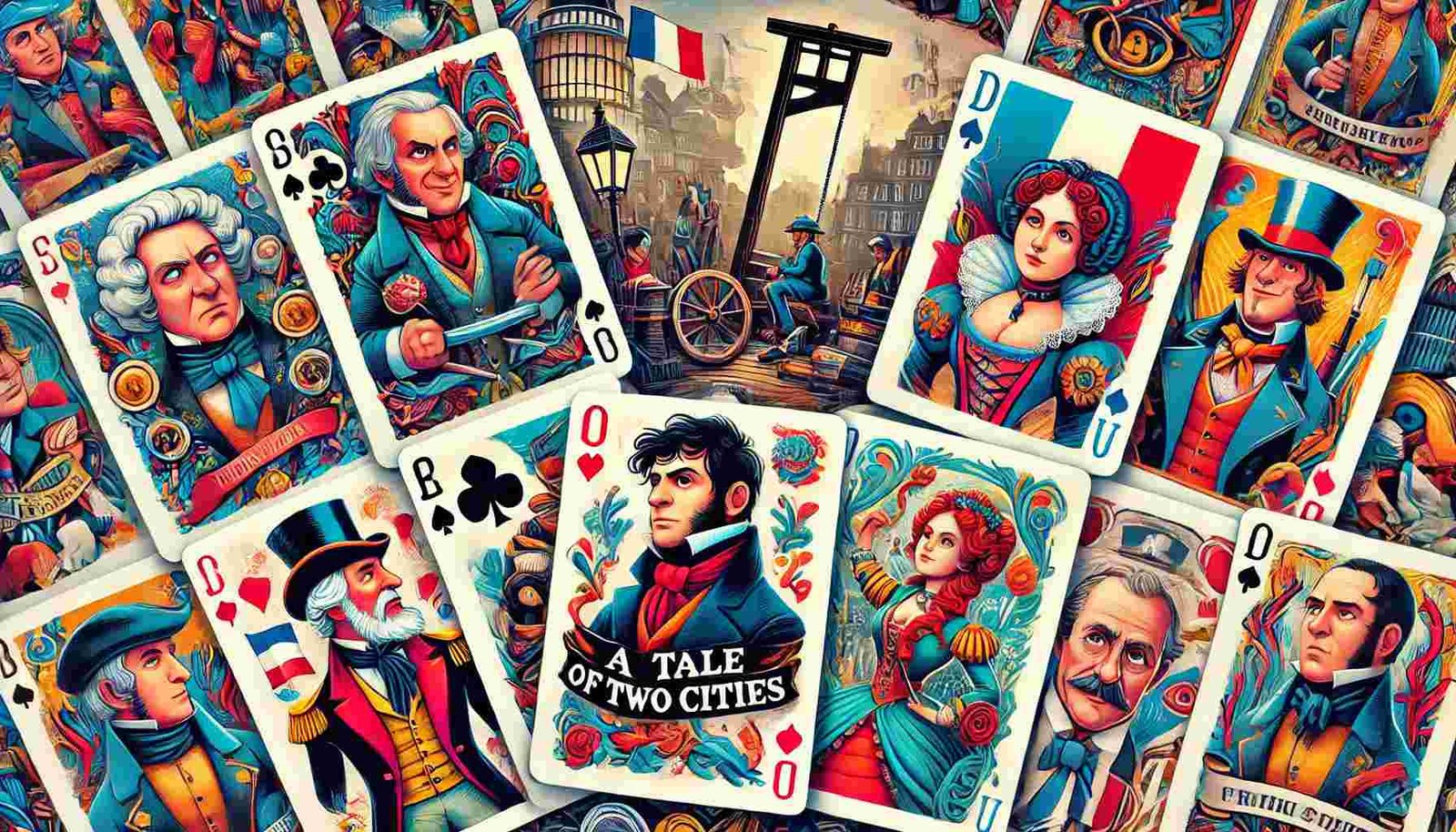Immerse yourself in the intrigue, deception, and drama of A Tale of Two Cities with this revolutionary card game and trivia drinking game! Choose your character, test your Dickens knowledge, and raise a glass to the French Revolution. Cheers to intrigue, alliances, and a bit of mayhem!
Table of Contents
A Hand at Cards – A Tale of Two Cities Inspired Game
A strategic card game for groups of up to 12 players, inspired by Charles Dickens’ A Tale of Two Cities, specifically Chapter 8 of Volume III. Players take on the roles of key characters, navigating intrigue, deception, and alliances to survive the turbulent times of the French Revolution.
What Do You Need For A Tale of Two Cities Card Game
- Players: 3 to 12 players, each with a unique character.
- Ability Cards: Prepare 64 blank pieces of paper or custom cards for character abilities, events, and locations.
- Influence Tokens: Use a deck of cards or poker chips to represent Influence tokens, symbolizing each player’s power.
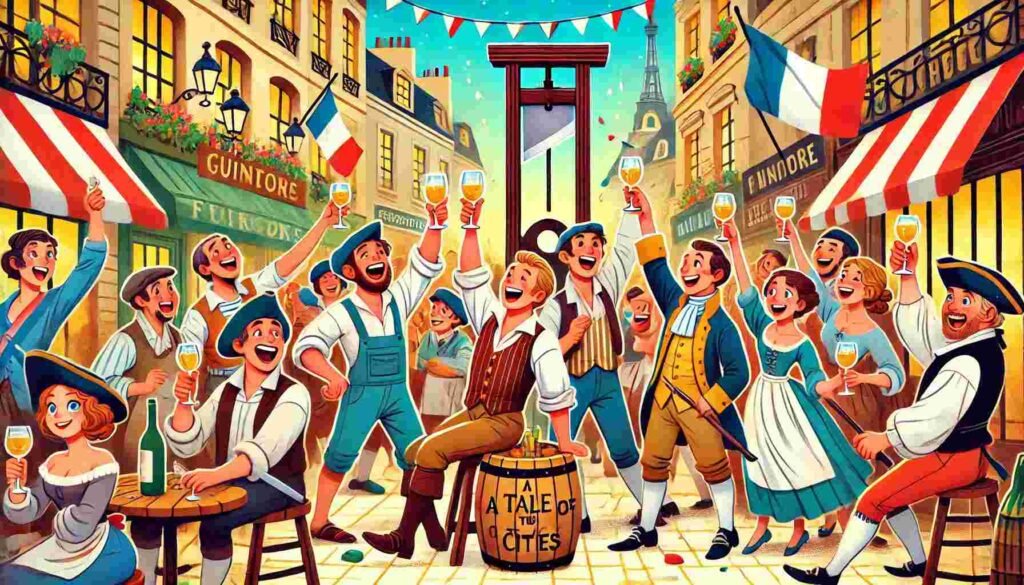
Custom Playing Cards for A Tale of Two Cities
12 Character Ability Cards
The game includes 12 Character Cards, each representing a key figure from A Tale of Two Cities. Each character has special abilities that align with their personality and role in the novel,
- Charles Darnay: “Noble Sacrifice” – Once per game, Darnay can sacrifice 2 Influence tokens to prevent an attack on himself or an ally.
- Sydney Carton: “Final Redemption” – At any time, Carton can discard all Influence tokens to give 3 tokens to another player, symbolizing his ultimate act of sacrifice.
- Madame Defarge: “Knitting of Vengeance” – When Defarge gains 5 Influence, she can reduce another player’s Influence by half.
- Dr. Alexandre Manette: “Healing Influence” – Once per game, Dr. Manette can restore 2 Influence tokens to himself or another player, symbolizing his journey of recovery and resilience.
- Lucie Manette: “Protective Charm” – Lucie can evade penalties or events once per game by “fainting,” effectively skipping her turn.
- Mr. Jarvis Lorry: “Banker’s Influence” – If Mr. Lorry is on a London Location Card, he gains an extra Influence each round due to his connections.
- Miss Pross: “Loyal Protector” – Once per game, Miss Pross can block an action directed at Lucie, showcasing her fierce loyalty.
- Ernest Defarge: “Revolutionary Rally” – When in Paris, Defarge gains an additional Influence token if any Revolution-themed Event Cards are played.
- The Vengeance: “Double Trouble” – If Madame Defarge is in play, The Vengeance gains +1 Influence whenever Defarge gains Influence.
- Marquis St. Evrémonde: “Noble Privilege” – When the Marquis is in London, he can evade any penalties once per game.
- John Barsad (Solomon Pross): “Double Agent” – Once per game, Barsad can switch alliances by trading hands with another player, keeping opponents guessing.
- Jerry Cruncher: “Resurrection Man” – Jerry can retrieve any discarded card once per game, adding it to his hand.
10 Event Cards
The deck includes 10 Event Cards across 5 categories, each capturing pivotal moments or scenarios that influence gameplay.
- “Trial” – The player on trial must sacrifice Influence or face a penalty.
- “Arrest” – The targeted player loses their next turn.
- “Escape” – Allows a player to avoid a penalty.
- “Betrayal” – A player must choose to either lose Influence or sever an alliance.
- “Revolution Rally” – All revolutionary characters gain Influence if this card is drawn.
30 Location Cards
Prepare 30 Location Cards across 6 categories. Location cards determine the setting of each round and can alter gameplay rules, particularly for characters with specific ties to Paris or London.
Paris Locations
- The Bastille – Revolutionary characters gain Influence.
- The Wine Shop – Defarges gain a bonus Influence.
- Guillotine Square – All characters must discard one Influence if they have 5 or more tokens.
London Locations
- The Old Bailey – Allows any English character to evade penalties.
- Tellson’s Bank – Mr. Lorry and other characters affiliated with England gain Influence.
- The Manette House – Lucie and Dr. Manette gain extra Influence here, as it symbolizes safety and family.
12 Action Cards
Action Cards allow players to make bold moves, either to gain Influence or disrupt their opponents. The deck contains 12 Action Cards across 4 categories that players can use to create alliances, challenge others, or protect themselves.
- “Spy” – Peek at another player’s hand, gathering information to gain the upper hand.
- “Defend” – Block another player’s action against you for one turn.
- “Challenge” – Engage in a duel of Influence; the winner gains a token, the loser sacrifices one.
- “Flee” – Escape a penalty or a Trial Event, protecting your Influence.
Influence Tokens
Prepare a deck of cards to represent tokens. Influence Tokens represent each player’s power and ability to sway others. Tokens are earned through successful actions, alliances, or specific Event Card outcomes. Influence is the key to winning, and players must strategize to gather and maintain their tokens while sabotaging others.
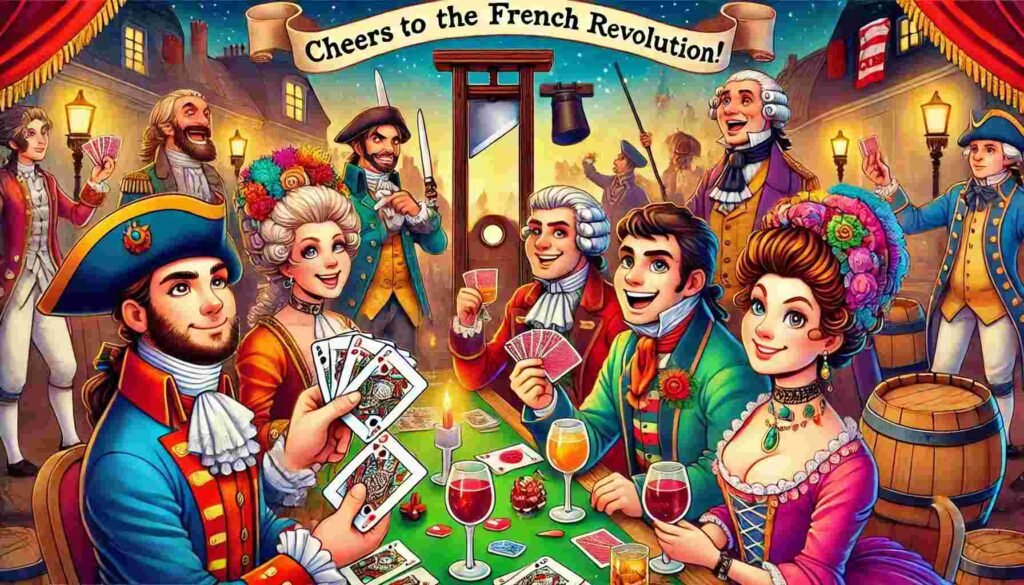
How to Play the A Tale of Two Cities Card Game
Prepare for the game
- Character Assignment: Each player draws a Character Card to play as a specific character with unique abilities.
- Influence Tokens: Each player starts with 2 Influence tokens.
- Deck Shuffle: Shuffle the Event, Location, and Action cards into separate decks.
- Starting Location: Draw one Location Card to establish the initial setting.
Each round represents a turn, with each player drawing cards and using them strategically to advance their position.
Phase 1: Location Setup
- Draw a new Location Card for the round, setting the scene (e.g., The Wine Shop, symbolizing a chance for gathering allies).
- Location Cards can modify rules or add bonuses for certain characters or actions.
Phase 2: Event Draw
Players draw an Event Card and must act based on the scenario. For instance, a “Trial” card could force the character to defend themselves by sacrificing Influence or facing penalties.
Phase 3: Action Phase
- Play Action Cards: Each player may play up to 2 Action Cards. These include moves like “Spy,” allowing a peek at another player’s hand, or “Flee,” which can avoid penalties.
- Strategic Alliances: Players can negotiate, form temporary alliances, or trade cards, mimicking the book’s themes of loyalty and betrayal.
Phase 4: Influence Gain
Players gain Influence points based on successful outcomes of their actions and Event Cards. For instance, a “Revolution Rally” event can grant Influence if certain characters (like Madame Defarge) are in play.
Winning the Game
The first player to accumulate 10 Influence points wins. Alternatively, if no player reaches 10 Influence by a certain number of rounds, the player with the most Influence at the end is declared the winner, representing their dominance in the Revolution’s turbulent environment.
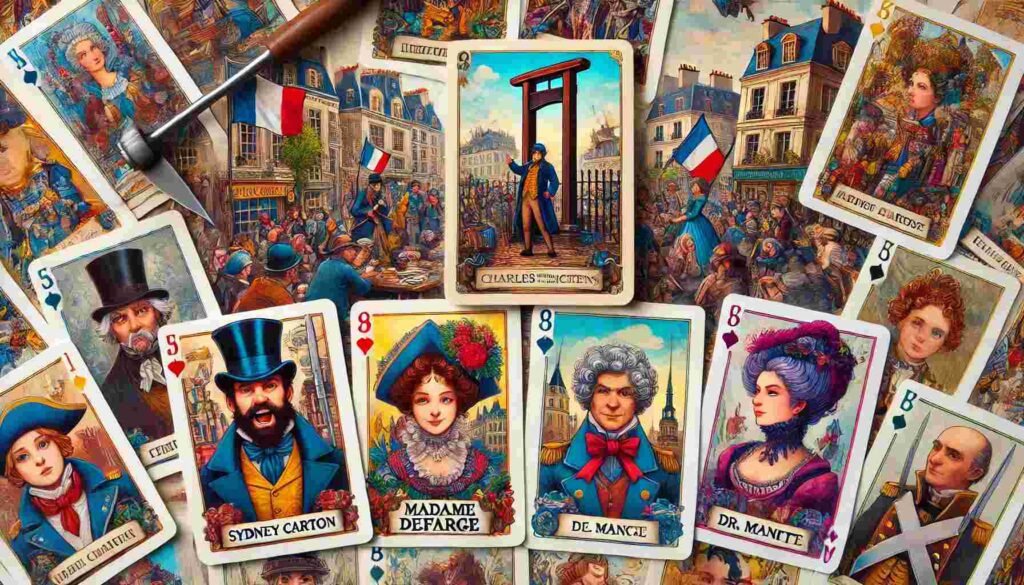
Drinking Rules for A Tale of Two Cities Card Game
These drinking rules add a humorous and lively twist to the game, giving players extra challenges that bring the drama of A Tale of Two Cities to life (in a very Dickensian, revolutionary sort of way!). Feel free to adapt or add to these based on your group’s preferences.
Influence Gain
- Whenever a player gains an Influence token, they may assign a drink to another player, representing their rising power and control. Sound familiar, like Presidents and Assholes card game? Exactly! Let’s celebrate “climbing up the social ladder”!
- If they gain two or more Influence in a single turn, they assign drinks equal to the number of tokens gained.
Location Drinking Rule
If the current Location Card is The Wine Shop, everyone drinks at the beginning of the round. Cheers to revolution!
Event Card Drinking Rules
Each Event Card type comes with a unique drinking rule for extra excitement:
- “Trial” Event: If a player draws the “Trial” card, they must drink for each Influence token they sacrifice in defense.
- “Betrayal” Event: The player drawing “Betrayal” drinks, but they may also assign a drink to anyone they feel has been untrustworthy.
- “Revolution Rally” Event: During this event, all players drink at the start of the round to signify the collective energy of the Revolution!
- “Escape” Event: If a player escapes any penalty or Influence loss, they take a celebratory drink and assign one to any player they “escaped” from.
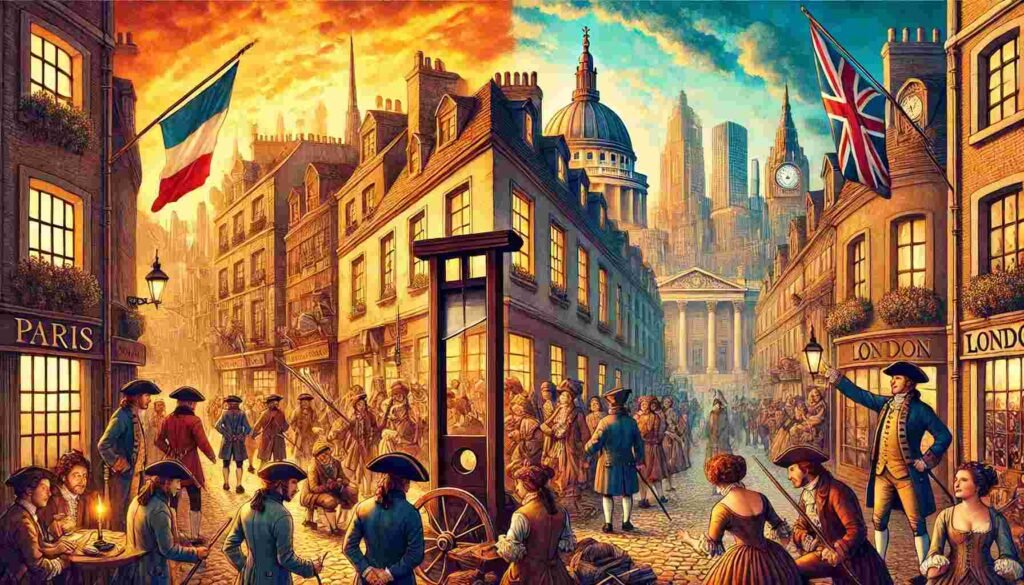
A Tale of Two Cities Trivia Drinking Game
If you’d rather skip the drinking rules for the card game, kick off a new round of the A Tale of Two Cities Trivia Drinking Game instead! With easy, medium, and hard levels, players can dive as deep as they dare into the story’s details, sharing laughs, surprises, and sips along the way.
Level 1: Easy
- Q: Who is the author of A Tale of Two Cities?
A: Charles Dickens. - Q: What are the two cities in the title?
A: Paris and London. - Q: Who says the famous line, “It was the best of times, it was the worst of times”?
A: The narrator. - Q: Who is Charles Darnay’s lookalike in the story?
A: Sydney Carton. - Q: What hobby does Madame Defarge use to track her enemies?
A: Knitting. - Q: Which historical event serves as the background for the novel?
A: The French Revolution. - Q: Who is Dr. Manette’s daughter?
A: Lucie Manette. - Q: In which country is Charles Darnay put on trial for treason?
A: England. - Q: What is Dr. Manette’s profession?
A: He is a physician. - Q: What object does Dr. Manette obsessively make while imprisoned?
A: Shoes.
Level 2: Medium
- Q: Who helps Charles Darnay avoid execution by posing as him?
A: Sydney Carton. - Q: What is the name of the wine shop owned by Ernest Defarge?
A: The Defarge Wine Shop. - Q: What does Madame Defarge knit into her work to mark her enemies?
A: Names. - Q: What is Dr. Manette’s prisoner identification number?
A: 105 North Tower. - Q: How many years was Dr. Manette imprisoned in the Bastille?
A: 18 years. - Q: Where does Charles Darnay’s first trial for treason take place?
A: The Old Bailey in London. - Q: Who recognizes Solomon Pross as the spy John Barsad?
A: Jerry Cruncher. - Q: Which character is described as having a “resurrection” ability because of his grave-digging job?
A: Jerry Cruncher. - Q: What does Sydney Carton do to gain access to Darnay’s prison cell?
A: He uses his resemblance to Darnay to switch places with him. - Q: What does the phrase “Recalled to Life” refer to in the story?
A: Dr. Manette’s release from prison after 18 years.
Level 3: Hard
- Q: What is the significance of the spilled wine outside the Defarge wine shop?
A: It symbolizes the coming bloodshed of the revolution. - Q: Who is Lucie Manette’s devoted protector and servant?
A: Miss Pross. - Q: What poem inspired Dickens to write A Tale of Two Cities?
A: “The Chimes,” another work by Dickens about social injustice. - Q: What name does Madame Defarge go by among the French revolutionaries?
A: La Vengeance. - Q: How does Charles Darnay prove his love for Lucie?
A: By renouncing his aristocratic title and inheritance. - Q: What crime is Charles Darnay falsely accused of in France?
A: Being an enemy of the Republic. - Q: Who delivers the news of Dr. Manette’s imprisonment to his wife?
A: The Marquis St. Evrémonde’s family. - Q: What phrase does Sydney Carton repeat in his final moments?
A: “It is a far, far better thing that I do, than I have ever done…” - Q: What instrument of execution becomes a symbol of the French Revolution?
A: The guillotine. - Q: How does the novel explore the theme of resurrection?
A: Through characters like Dr. Manette, who is “recalled to life,” and Carton, who finds redemption.
Are you ready to enter the world of A Tale of Two Cities? Whether you’re battling for Influence tokens, outwitting your friends, or challenging your knowledge with the trivia game, every round brings the thrill of revolution to your table. Grab your cards, sharpen your strategy, and raise a glass to a night of alliances, sacrifices, and sips—may the best revolutionary (or noble) win!
